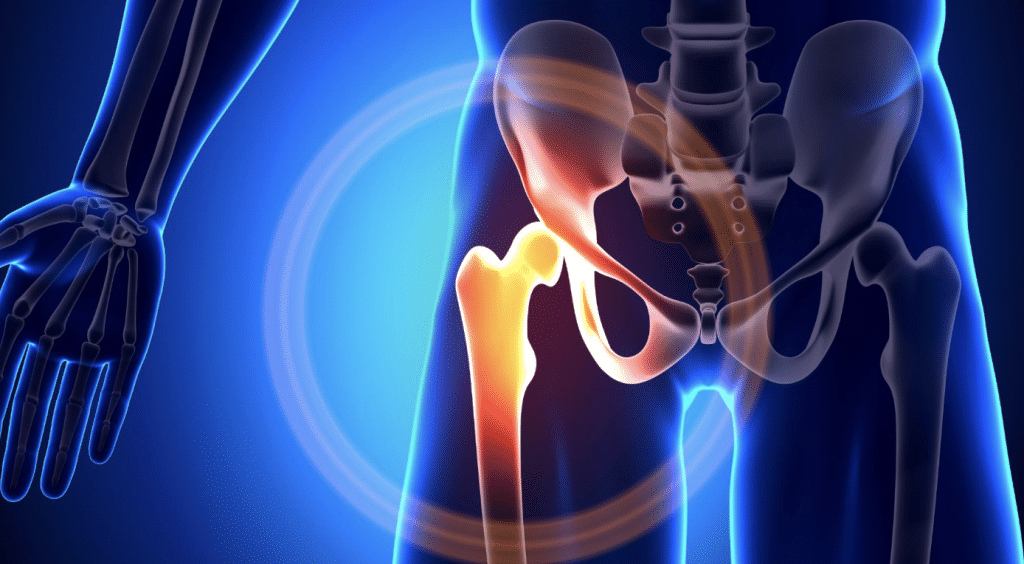Hip osteoarthritis is a common and debilitating condition that affects millions globally, causing pain and limiting mobility. According to the World Health Organization, it is a leading cause of disability among older adults, with about 10% of men and 18% of women over 60 affected. Managing hip osteoarthritis often requires exploring various treatment options to alleviate discomfort and improve quality of life.
One such treatment is Durolane, an injectable hyaluronic acid product designed to relieve pain by lubricating the hip joint. Durolane aims to reduce inflammation and improve joint function as a non-surgical option.
In this article, we will explore the benefits, usage, and potential side effects of Durolane for hip osteoarthritis, providing comprehensive information for those looking to get this treatment.
Key Takeaways
- Durolane is a special treatment using high-molecular-weight hyaluronic acid. It helps to ease pain and improve joint function in hip osteoarthritis patients by supporting smooth movement and protecting cartilage.
- Studies back up the use of Durolane, with one showing that patients saw their hip score improve notably six weeks after an injection. This points out its effectiveness in not just managing but significantly reducing pain.
- Even though it’s effective, Durolane isn’t for everyone. Kids, pregnant or breastfeeding women should avoid it. Also, folks with skin diseases near the shot area need to stay clear due to infection risks.
- Giving a Durolane injection demands careful steps, including using ultrasound or fluoroscopic guidance for accuracy. This ensures the needle goes just where needed without much discomfort.
About: Medical Spa RX provides medical practices with premium products at the best prices. If you’re looking to buy Lumigan online for your practice, the sales representatives at Medical Spa RX can give you guidance.
Overview of Hip Osteoarthritis
Hip osteoarthritis (OA) is a degenerative joint disease characterized by the breakdown of cartilage in the hip joint, leading to pain, stiffness, and reduced mobility. It is one of the most common forms of arthritis, particularly affecting older adults.
Symptoms of hip osteoarthritis include persistent hip pain, especially during or after movement, stiffness in the hip joint after periods of inactivity or rest, and reduced range of motion. These symptoms can significantly impact a patient’s quality of life, limiting their ability to perform everyday activities, reducing physical fitness, and contributing to emotional distress due to chronic pain and mobility issues.
Challenges in Managing Hip Osteoarthritis

Despite the prevalence of hip osteoarthritis, there remains a significant treatment gap. While early interventions can slow disease progression, there are limited options to reverse joint damage or regenerate cartilage.
Traditional pain management methods, such as nonsteroidal anti-inflammatory drugs (NSAIDs) and corticosteroid injections, carry notable risks.
- Long-term use of NSAIDs can lead to gastrointestinal issues, cardiovascular problems, and kidney damage.
- While effective in reducing inflammation, corticosteroid injections can accelerate joint degeneration and are associated with side effects such as joint infection and weakening of the bones and tendons around the joint.
Introduction to Durolane

Durolane is a groundbreaking treatment that offers new hope to those with hip osteoarthritis. It offers a unique way to manage pain and improve joint function. Made from non-animal-derived hyaluronic acid (HA), Durolane leverages the natural lubricating and cushioning properties of HA found in the body, particularly in the joints.
Durolane’s unique formulation provides significant benefits for treating hip osteoarthritis. The high-molecular-weight HA helps to lubricate the joint, reduce inflammation, and maintain cartilage integrity. This advanced approach not only alleviates pain but also supports long-term joint health.
Medical professionals and patients often compare treatments like Durolane vs Euflexxa to assess efficacy and outcomes, with Durolane frequently noted for its superior performance in providing sustained relief.
Durolane offers a promising alternative for those seeking effective, non-surgical options for managing hip osteoarthritis by utilizing this cutting-edge HA formulation.
Efficacy and Safety of Durolane for Hip Osteoarthritis

Clinical studies have shown Durolane to be an effective treatment for hip osteoarthritis. Over 20 clinical trials endorse its use for long-lasting pain relief and patient function improvement.
Durolane has shown promising results in managing hip osteoarthritis. Real-world evidence and patient case reports highlight its efficacy and safety.
- After six weeks, the Modified Harris Hip Score (mHHS) improved significantly, gaining 12.83 points from the baseline.
- This improvement exceeded the minimum clinically significant difference (MCID), set at 10 points, indicating significant patient relief.
- The research covered two years at a single site, offering a robust dataset for analysis and conclusions on Durolane’s effectiveness.
Patient Selection for Durolane Treatment
Durolane is most effective for patients with mild to moderate hip osteoarthritis, characterized by pain, stiffness, and reduced joint function due to cartilage wear and inflammation. It aims to provide symptomatic relief and improve overall joint function.
When conservative treatments like physical therapy, weight management, and pain medications are insufficient, Durolane becomes a viable option. Patients who continue to suffer from pain despite these non-surgical approaches may benefit from Durolane injections.
Additionally, individuals whose daily activities are limited by hip osteoarthritis, such as difficulty walking, climbing stairs, or performing routine tasks, may find Durolane helpful. The treatment aims to enhance joint mobility and improve the quality of life for these patients.
Precautions for Patients with Specific Medical Conditions
- Infections: Durolane should not be used in patients with active infections near the injection site to prevent the risk of spreading the infection.
- Skin Diseases: Patients with skin conditions at the injection area should avoid Durolane to prevent exacerbating their condition.
- Pregnancy and Lactation: There is no data on the effects of Durolane during pregnancy or lactation; thus, it is advised to avoid its use in pregnant or breastfeeding women.
- Children: Due to the lack of clinical data, Durolane is not recommended for use in children.
Injection Techniques for Durolane in the Hip
- Patient Positioning: Position the patient comfortably, either sitting or lying down. Ensure proper exposure of the hip joint area.
- Sterile Preparation: Follow strict aseptic techniques. Cleanse the skin overlying the greater trochanter (lateral aspect of the hip) with an antiseptic solution.
- Needle Selection: Choose an appropriate needle length (usually 1.5 inches) for intra-articular injection. For optimal flow, use a 22- or 25-gauge needle.
- Anatomical Landmarks: Identify the greater trochanter and palpate the femoral head. Mark the injection site, typically at the midpoint between these landmarks.
- Insertion Point: Insert the needle perpendicular to the skin at the marked site. Aim for the center of the hip joint space.
- Aspiration and Confirmation: Aspirate to ensure no blood or synovial fluid is drawn into the syringe. Confirm proper needle placement within the joint space.
- Durolane Injection: Slowly inject Durolane into the hip joint. Maintain a steady hand to prevent sudden movements.
- Withdrawal and Pressure: Withdraw the needle slowly. Apply gentle pressure to the injection site using sterile gauze.
Best Practices for Ensuring Precision and Patient Comfort
- Use of Imaging: Employ ultrasound or fluoroscopy to guide the needle accurately into the joint space and ensure precise delivery of the hyaluronic acid.
- Local Anesthesia: Administer a local anesthetic to minimize patient discomfort during the procedure.
- Slow Injection: Inject Durolane slowly to reduce pressure and discomfort within the joint.
- Patient Communication: Keep the patient informed throughout the procedure to alleviate anxiety and ensure their comfort with each step.
- Post-Procedure Monitoring: Monitor the patient for any immediate adverse reactions and provide clear instructions to optimize recovery and effectiveness post-injection care.
Post-Treatment Care and Follow-Up
After Durolane injections, patients should avoid strenuous activities for 24-48 hours to allow the joint to settle. Light activities are encouraged to maintain mobility without stressing the joint. Follow-up appointments are crucial to assess the treatment’s effectiveness, monitor for adverse reactions, and address patient concerns.
Over-the-counter pain relievers and ice packs can manage common side effects, such as mild swelling, pain, or bruising. Patients should be informed about these potential side effects and instructed to report any severe symptoms, such as increased pain, redness, or fever, immediately.
Effective communication and comprehensive post-treatment care ensure patients receive the full benefits of Durolane and enhance their overall treatment experience.
Conclusion
Durolane brings hope to those with hip osteoarthritis. This treatment eases pain and improves movement for up to 6 months. Doctors see it as a safe choice for many, though not all, patients.
Having been used by to manage osteoarthritis for over 20 years, its benefits are clear. Durolane might be the relief you’re looking for in managing hip arthritis pain.
FAQs
1. What exactly is Durolane, and how does it work for hip osteoarthritis treatment?
Durolane is a unique, non-surgical technique for hip osteoarthritis. It’s injected directly into the joint to help restore lubrication, reduce pain, and improve mobility.
2. Is there any difference between Durolane and other treatments available on the market?
Yes indeed! Unlike some treatments that only address symptoms, Durolane works at the source of your discomfort. It helps restore natural joint function in a way that many other treatments don’t.
3. How safe is using Durolane as a treatment method?
Durolane has been proven safe through rigorous testing and studies. However, like all medical procedures, it comes with risks, which should be discussed thoroughly with your healthcare provider before proceeding.
4. Can anyone suffering from hip osteoarthritis use Durolane?
While Durolane can relieve individuals suffering from hip osteoarthritis, It’s only suitable for some. Your doctor will consider factors such as your overall health condition before deciding if this treatment is right for you.
References
World Health Organization. (2019). Osteoarthritis. Retrieved from https://www.who.int/news-room/fact-sheets/detail/osteoarthritis
Fan Z, Yan L, Liu H, et al. The prevalence of hip osteoarthritis: a systematic review and meta-analysis. Arthritis Research & Therapy. 2023;25(1). doi:10.1186/s13075-023-03033-7
Allen KD, Thoma LM, Golightly YM. Epidemiology of osteoarthritis. Osteoarthritis and Cartilage. 2022;30(2):184-195. doi:10.1016/j.joca.2021.04.020





















